Application of Porous Nickel-Coated TiO2 for the Photocatalytic Degradation of Aqueous Quinoline in an Internal Airlift Loop Reactor
Abstract
:1. Introduction
2. Materials and Methods
2.1. Materials
2.2. Preparation and Characterization of the Photocatalyst
2.3. Photocatalytic Reactor
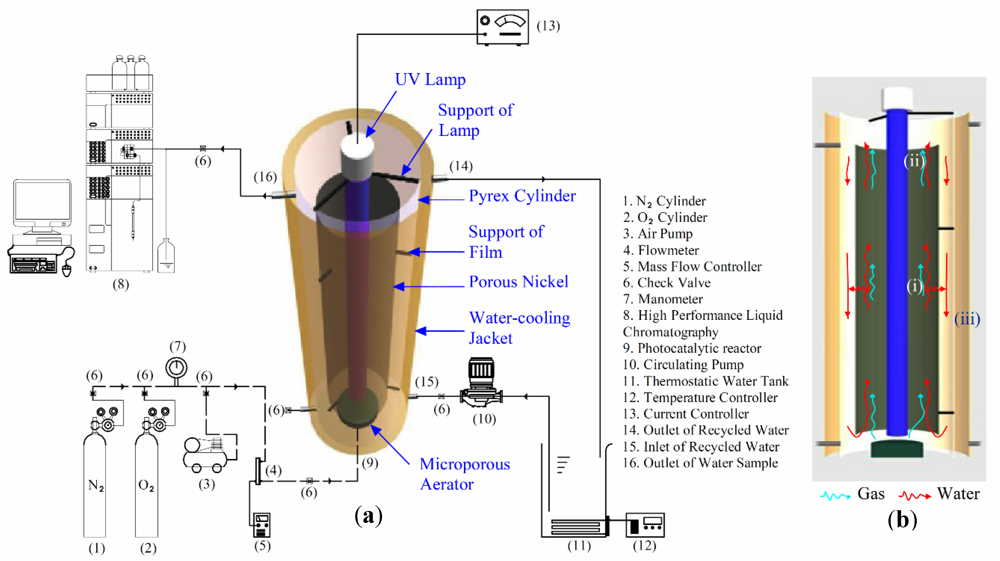
2.4. Procedure and Analysis
3. Results and Discussion
3.1. TiO2/Ni Film Characterizations
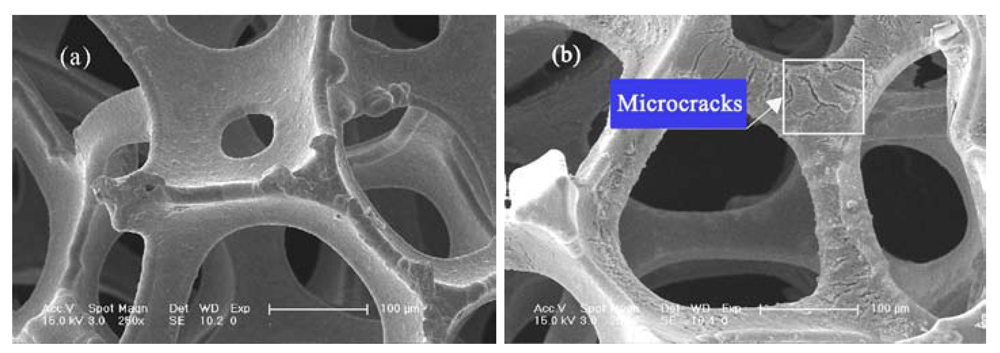
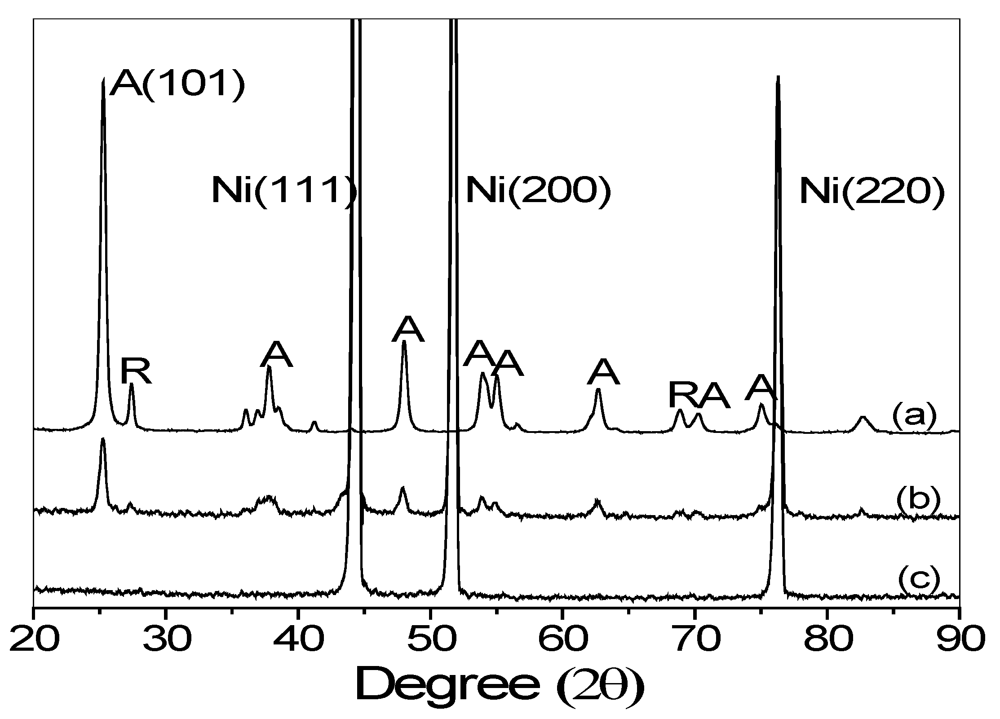
3.2. Photodegradation of Quinoline in the Photocatalytic Reactor
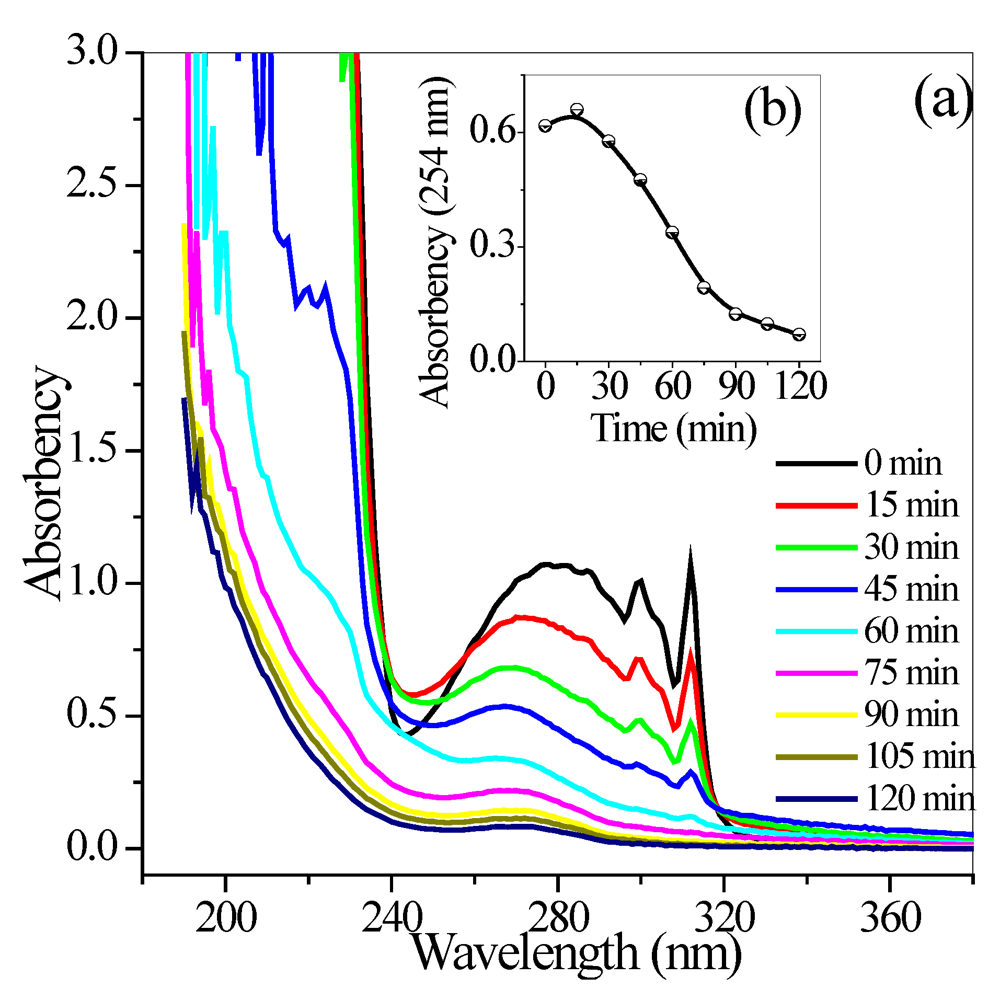
3.2.1. Effect of the Initial Quinoline Concentration
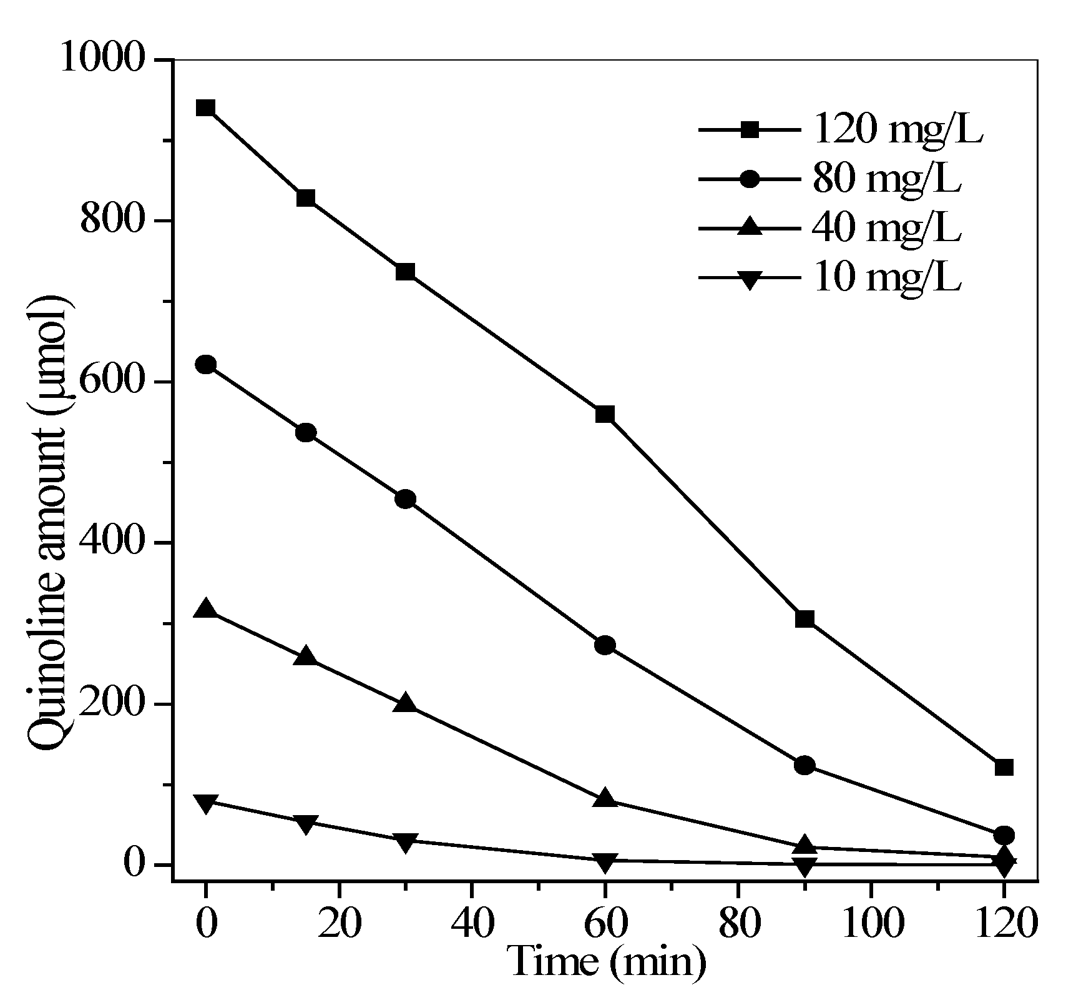
3.2.2. Effect of Light Intensity

3.2.3. Effect of Reaction Temperature
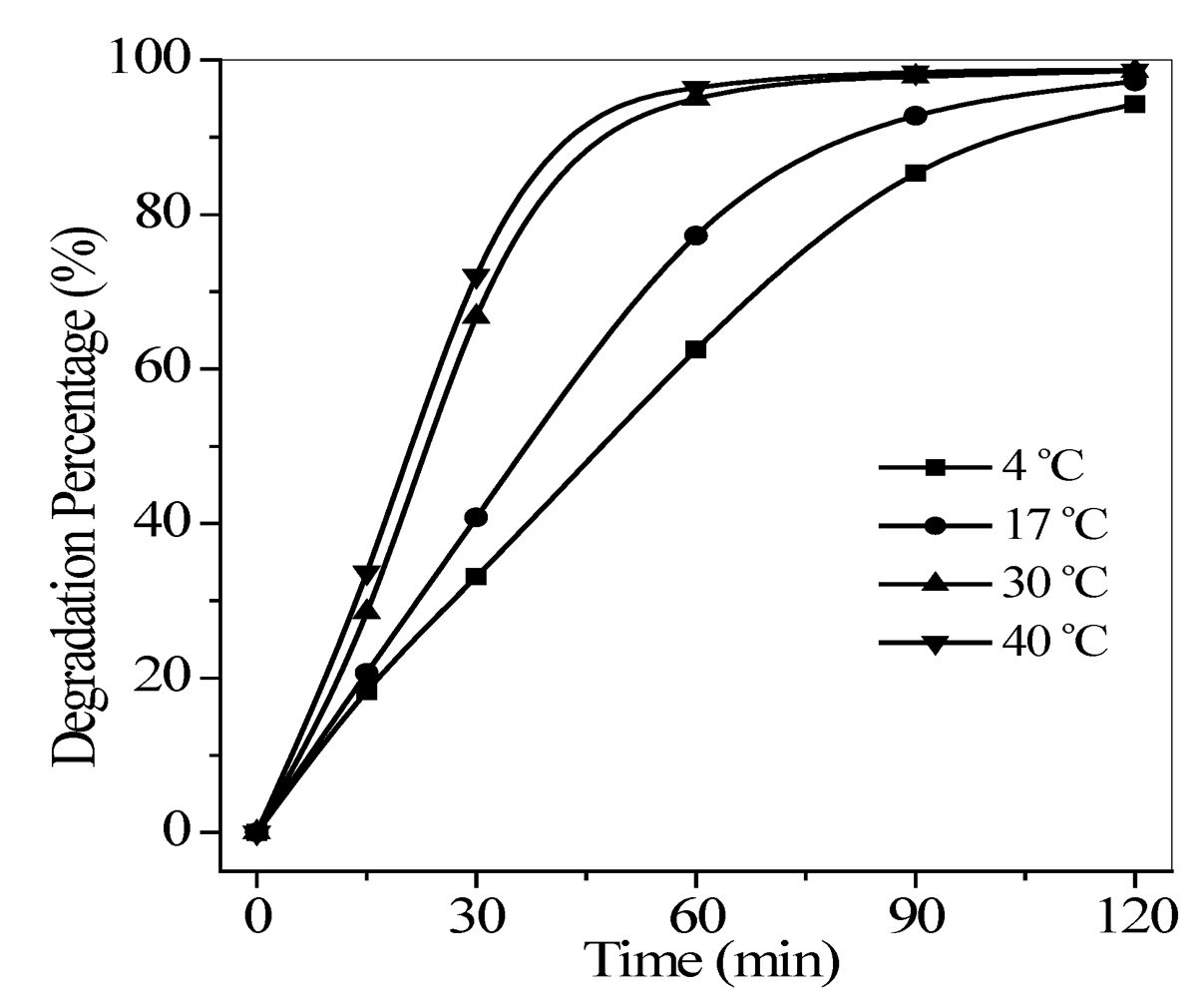
3.2.4. Effect of Aeration

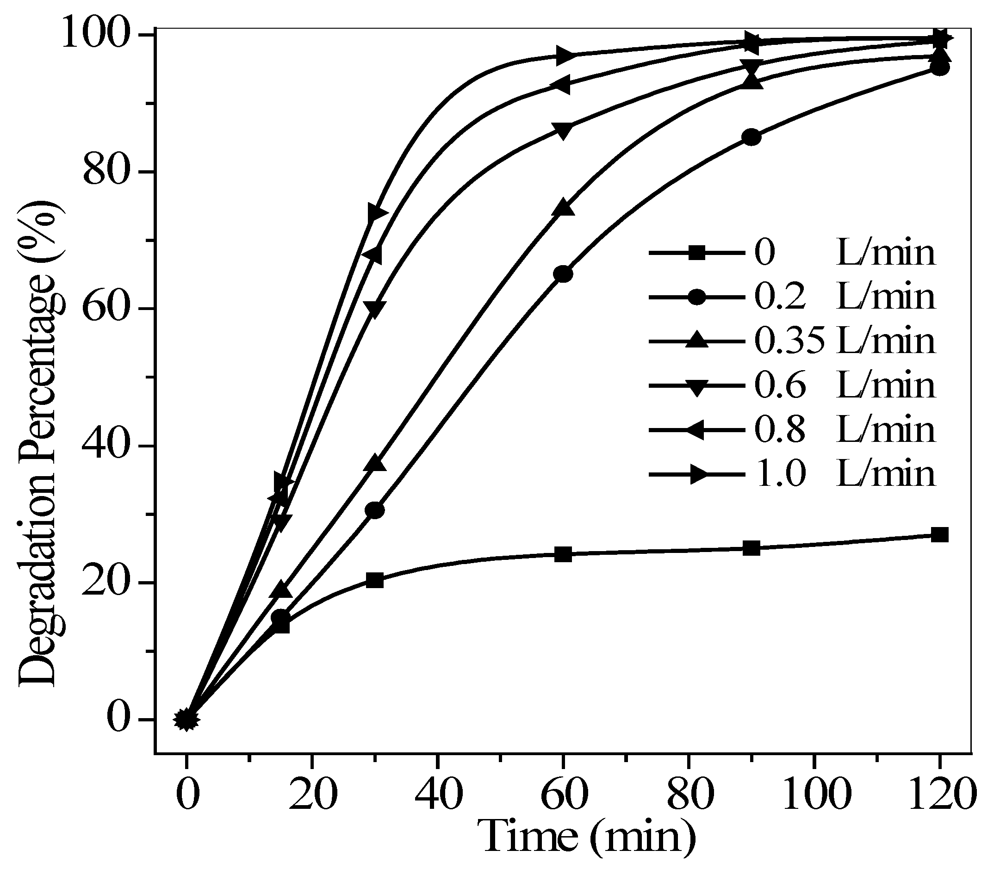
3.2.5. Effect of pH
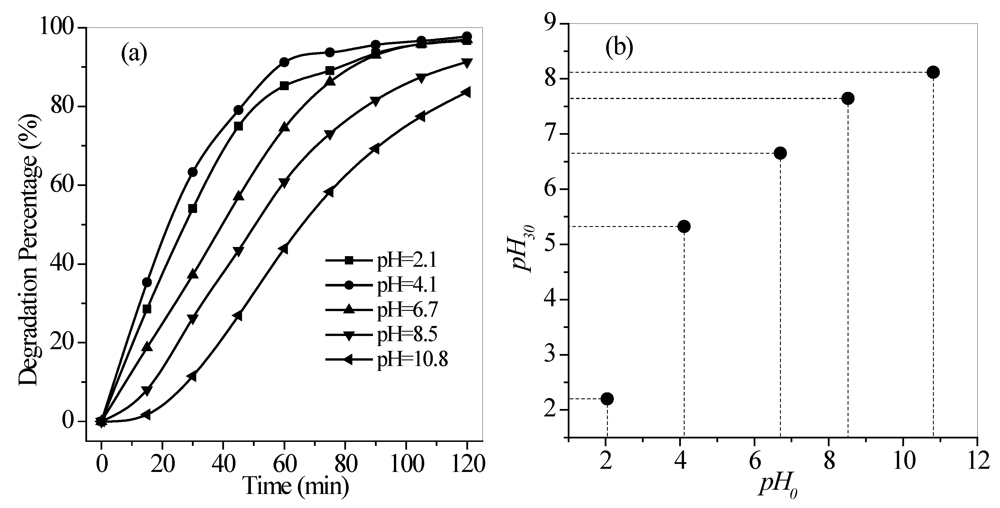
3.2.6. Stability of the TiO2/Ni Film

3.3. Mechanism of Quinoline Degradation

4. Conclusions
Acknowledgements
References
- Seo, J.S.; Keum, Y.S.; Li, Q.X. bacterial degradation of aromatic compounds. Int. J. Environ. Res. Public Health 2009, 6, 278–309. [Google Scholar]
- Tao, X.Q.; Lu, G.N.; Liu, J.P.; Li, T.; Yang, L.N. Rapid Degradation of Phenanthrene by Using Sphingomonas sp. GY2B Immobilized in Calcium Alginate Gel Beads. Int. J. Environ. Res. Public Health 2009, 6, 2470–2480. [Google Scholar] [CrossRef]
- Kochany, J.; Maguire, R.J. Photodegradation of quinoline in water. Chemosphere 1994, 28, 1097–1110. [Google Scholar]
- Alexei, N.; John, K. Parameters affecting the homogeneous and heterogeneous degradation of quinoline solutions in light-activated processes. J. Photoch. Photobio. A 1997, 110, 149–157. [Google Scholar]
- Rockafellow, E.M.; Stewart, L.K.; Jenks, W.S. Is sulfur-doped TiO2 an effective visible light photocatalyst for remediation? Appl. Catal. B-Environ. 2009, 91, 554–562. [Google Scholar] [CrossRef]
- Stewart, L.K. Tungsten Trioxide and Titanium Dioxide Photocatalytic Degradations of Quinoline. 2009. [Google Scholar]
- Pichat, P. Photocatalytic degradation of aromatic and alicyclic pollutants in water: by-products, pathways and mechanisms. Water. Sci. Technol. 1997, 35, 73–78. [Google Scholar]
- Kim, S.B.; Jang, H.T.; Hong, S.C. Photodegradation of gas-phase methanol and toluene using thin-film TiO2 photocatalyst. 1. Influence of water vapor, molecular oxygen and temperature. J. Ind. Eng. Chem. 2002, 8, 156–161. [Google Scholar]
- Xu, X.; Ji, F.Y.; Fan, Z.H.; He, L. Degradation of Glyphosate in Soil Photocatalyzed by Fe3O4/SiO2/TiO2 under Solar Light. Int. J. Environ. Res. Public Health 2011, 8, 1258–1270. [Google Scholar]
- Rodriguez, P.; Meille, V.; Pallier, S.; Al Sawah, M.A. Deposition and characterisation of TiO2 coatings on various supports for structured (photo)catalytic reactors. Appl. Catal. A-Gen. 2009, 360, 154–162. [Google Scholar] [CrossRef]
- Yang, L.P.; Liu, Z.Y.; Shi, J.W.; Hu, H.; Shangguan, W.F. Design consideration of photocatalytic oxidation reactors using TiO2-coated foam nickels for degrading indoor gaseous formaldehyde. Catal. Today 2007, 126, 359–368. [Google Scholar]
- Zhu, S.Y.; Yang, X.; Wang, G.N.; Zhang, L.L.; Zhu, H.F.; Huo, M.X. Facile Preparation of P25 Films Dip-Coated Nickel Foam and High Photocatalytic Activity for the Degradation of Quinoline and Industrial Wastewater. Int. J. Chem. React. Eng. 2011, 9, A37. [Google Scholar]
- Taranto, J.; Frochot, D.; Pichat, P. Photocatalytic Treatment of Air: Comparison of Various TiO2, Coating Methods, and Supports Using Methanol or n-Octane as Test Pollutant. Ind. Eng. Chem. Res. 2009, 48, 6229–6236. [Google Scholar]
- Olivier, R.; Muthukonda, V.S.; Maithaa, K.D.; Loïc, S.; Nicolas, K.; Valérie, K. Solar light photocatalytic hydrogen production from water over Pt and Au/TiO2 (anatase/rutile) photocatalysts: Influence of noble metal and porogen promotion. J. Catal. 2010, 269, 179–190. [Google Scholar]
- Plantard, G.; Correia, F.; Goetz, V. Kinetic and efficiency of TiO2-coated on foam or tissue and TiO2-suspension in a photocatalytic reactor applied to the degradation of the 2,4-dichlorophenol. J. Photoch. Photobio. 2011, 222, 111–116. [Google Scholar]
- Barakat, M.A. Adsorption and photodegradation of procion yellow H-EXL dye in textile wastewater over TiO2 suspension. J. Hydro-Environ. Res. 2011, 5, 137–142. [Google Scholar] [CrossRef]
- Li, Y.M.; Gu, G.W.; Zhao, J.F.; Yu, H.Q.; Qiu, Y.L.; Peng, Y.Z. Treatment of coke-plant wastewater by biofilm systems for removal of organic compounds and nitrogen. Chemosphere 2003, 52, 997–1005. [Google Scholar]
- Zhang, Y.H.; Yang, Y.N.; Xiao, P.; Zhang, X.N.; Lu, L.; Li, L. Preparation of Ni nanoparticle-TiO2 nanotube composite by pulse electrodeposition. Mater Lett. 2009, 63, 2429–2431. [Google Scholar]
- Bidault, F.; Brett, D.J.L.; Middleton, P.H.; Abson, N.; Brandon, N.P. A new application for nickel foam in alkaline fuel cells. Int. J. Hydrogen. Energ. 2009, 34, 6799–6808. [Google Scholar]
- JCPDS PDF-2 Release 2001; ICDD: Newtown Square, PA, USA, 2001.
- Kulovaara, M.; Corin, N.; Backlund, P.; Tervo, J. Impact of UV254-radiation on aquatic humic substances. Chemosphere 1996, 33, 783–790. [Google Scholar]
- Bouanimba, N.; Zouaghi, R.; Laid, N.; Sehili, T. Factors influencing the photocatalytic decolorization of Bromophenol blue in aqueous solution with different types of TiO2 asphotocatalysts. Desalination 2011, 275, 224–230. [Google Scholar]
- Qian, Ch.X.; Zhao, L.F.; Fu, D.F.; Li, L.; Wang, R.X. Study on the effect of temperature, humidity and light intensity on photocatalytic oxidation of NO2 by Nano-TiO2 immobilized on cement-based materials. J. Environ. Sci. China 2005, 25, 623–630. [Google Scholar]
- Chen, D.W.; Ray, A.K. Photodegradation kinetics of 4-nitrophenol in TiO2 suspension. Water Res. 1998, 32, 3223–3234. [Google Scholar]
- Chung, H.H.; MariÑas, B.J. Role of Chlorine and Oxygen in the Photocatalytic Degradation of Trichloroethylene Vapor on TiO2 Films. Environ. Sci. Technol. 1997, 31, 562–568. [Google Scholar]
- Singh, H.K.; Saquib, M.; Haque, M.M.; Muneer, M. Heterogeneous photocatalyzed degradation of uracil and 5-bromouracil in aqueous suspensions of titanium dioxide. J. Hazard. Mater. 2007, 142, 425–430. [Google Scholar]
- Singh, H.K.; Saquib, M.; Haque, M.M.; Muneer, M. Heterogeneous photocatalysed decolorization of two selected dye derivatives neutral red and toluidine blue in aqueous suspensions. Chem. Eng. J. 2008, 136, 77–81. [Google Scholar]
- Lu, M.C.; Roam, G.D.; Chen, J.N.; Huang, C.P. Factors affecting the photocatalytic degradation of dichlorvos over titanium dioxide supported on glass. J. Photochem. Photobiol. A. 1993, 76, 103–110. [Google Scholar]
- Renault, N.J.; Pichat, P.; Foissy, A.; Mercier, R. Study of the effect of deposited Pt particles on the surface charge of TiO2 aqueous suspensions by potentiometry, electrophoresis and labeled ion adsorption. J. Phys. Chem. 1986, 90, 2733–2738. [Google Scholar]
- Wang, S.L.; Zheng, Z.; Li, M. Pulse radiolysis mechanism study of quinoline in dilute solutions. J. Radiat. Res. Proc. China 2004, 22, 334–338. [Google Scholar]
- Chen, D.W.; Ray, A.K. Photodegradation kinetics of 4-nitrophenol in TiO2 suspension. Water Res. 1998, 32, 3223–3234. [Google Scholar]
- Lapertot, M.; Pichat, P.; Parra, S.; Guillard, C.; Pulgarin, C. Photocatalytic degradation of p-halophenols in TiO2 aqueous suspensions: halogen effect on removal rate, aromatic intermediates and toxicity variations. J. Environ. Sci. Health A 2006, 41, 1009–1025. [Google Scholar]
- Thomsen, A.B. Degradation of quinoline by wet oxidation kinetic aspects and reaction mechanisms. Water Res. 1998, 32, 136–146. [Google Scholar]
- Zhu, D.Z.; Sun, D.M.; Jiang, Z.L.; Wang, S.L.; Sun, X.Y.; Ni, Y.M. Studies on the Respective Reactions of Quinoline and Isoquinoline with Transient Species by Pulse Radiolysis. Acta Phys. Chim. Sin. 2008, 24, 2321–2326. [Google Scholar]
- Ishibashi, K.I.; Fujishima, A.; Watanabe, T.; Hashimoto, K. Generation and Deactivation Processes of Superoxide Formed on TiO2 Film Illuminated by Very Weak UV Light in Air or Water. J. Phys. Chem. B 2000, 104, 4934–4938. [Google Scholar]
- Ishibashi, K.I.; Nosaka, Y.; Hashimoto, K.; Fujishima, A. Time-Dependent Behavior of Active Oxygen Species Formed on Photoirradiated TiO2 Films in air. J. Phys. Chem. B 1998, 102, 2117–2120. [Google Scholar]
- Wang, S.L.; Zhu, D.Z.; Sun, X.Y.; Shi, J.; Ni, Y.M.; Wang, W.F.; Yao, S.D. Spectral Analysis of Transient Species of Quinoline Degradation. Spectrosc. Spect. Anal. 2006, 26, 1479–1482. [Google Scholar]
© 2012 by the authors; licensee MDPI, Basel, Switzerland. This article is an open-access article distributed under the terms and conditions of the Creative Commons Attribution license (http://creativecommons.org/licenses/by/3.0/).
Share and Cite
Zhu, S.; Yang, X.; Yang, W.; Zhang, L.; Wang, J.; Huo, M. Application of Porous Nickel-Coated TiO2 for the Photocatalytic Degradation of Aqueous Quinoline in an Internal Airlift Loop Reactor. Int. J. Environ. Res. Public Health 2012, 9, 548-563. https://doi.org/10.3390/ijerph9020548
Zhu S, Yang X, Yang W, Zhang L, Wang J, Huo M. Application of Porous Nickel-Coated TiO2 for the Photocatalytic Degradation of Aqueous Quinoline in an Internal Airlift Loop Reactor. International Journal of Environmental Research and Public Health. 2012; 9(2):548-563. https://doi.org/10.3390/ijerph9020548
Chicago/Turabian StyleZhu, Suiyi, Xia Yang, Wu Yang, Leilei Zhang, Jian Wang, and Mingxin Huo. 2012. "Application of Porous Nickel-Coated TiO2 for the Photocatalytic Degradation of Aqueous Quinoline in an Internal Airlift Loop Reactor" International Journal of Environmental Research and Public Health 9, no. 2: 548-563. https://doi.org/10.3390/ijerph9020548
APA StyleZhu, S., Yang, X., Yang, W., Zhang, L., Wang, J., & Huo, M. (2012). Application of Porous Nickel-Coated TiO2 for the Photocatalytic Degradation of Aqueous Quinoline in an Internal Airlift Loop Reactor. International Journal of Environmental Research and Public Health, 9(2), 548-563. https://doi.org/10.3390/ijerph9020548



